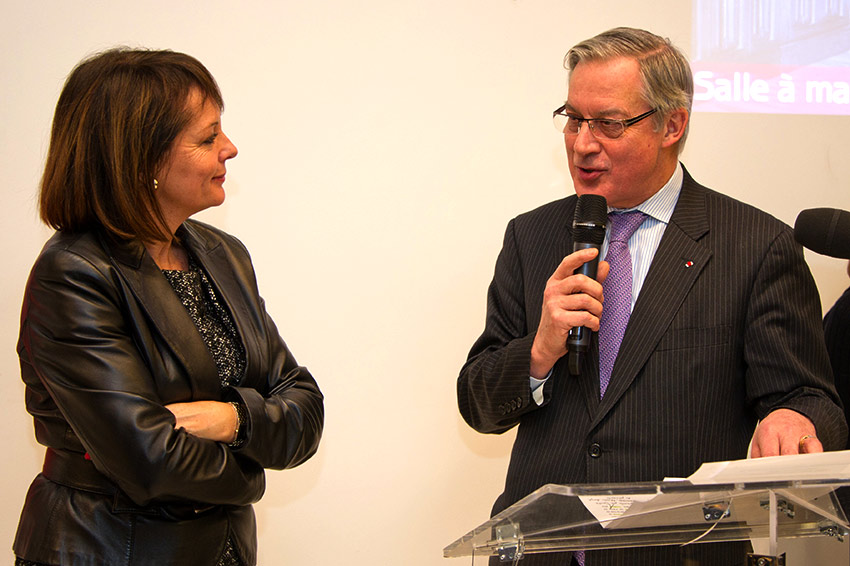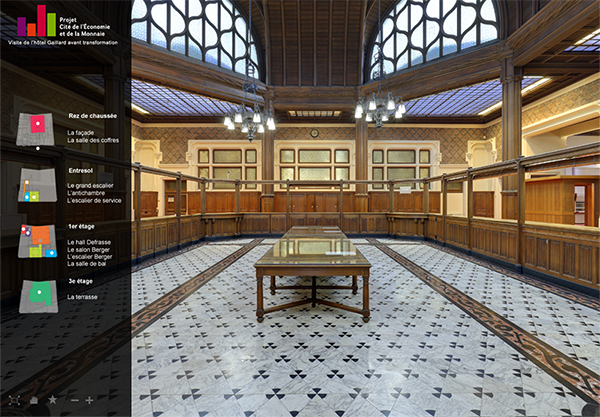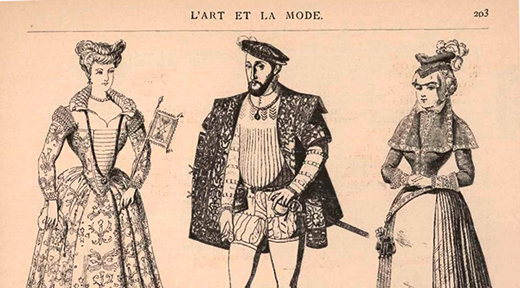On 10 April 1885, Émile Gaillard hosted a costumed ball for his second daughter, Jeanne, to which more than 2,000 guests were invited. The event was also an inauguration party for the new mansion, the Hôtel Gaillard, completed just two or three years earlier and already described as “marvellous”, “magnificent”, “astonishing” and “magical”.
A problem with the date
The costumed ball was announced in the press in February and was to be one of the opening events of the social season, after the break for Lent. The article in national daily Le Figaro read “Invitations have already been sent out for various balls due to take place after Lent. M. and Mme Gaillard, owners of the beautiful mansion on place Malesherbes, a striking reproduction of the Château of Blois, will be holding a costumed ball, set for 11 April.” (28 February 1885).
However, Émile Gaillard’s plans were overtaken by current events: a major reception was organised on the same date at Paris’ Hôtel de Ville to raise funds for the families of French soldiers wounded or killed in the ongoing war between France and China for control of Tonkin.
“On learning that the ball at the Hôtel de Ville was scheduled to take place on 11 April next, M. Gaillard, who resides at place Malesherbes, has gallantly decided to bring his own costumed ball forward by a day, to 10 April,” Le Figaro wrote on 8 March.
Dressing up
Preparations for the ball could thus begin in earnest, and for the guests, the burning question was: what to wear? “Are you going to Émile Gaillard’s ball? What are you going as? Who is making your costume? It’s the talk of the town. Imagine! A costumed ball, hosted by one of Parisian society’s greatest aesthetes and connoisseurs, at his very own Château of Blois on place Malesherbes, one of the most magnificent, most astonishing and least known squares in the city. Little surprise the city is awash with excitement. Guests are scouring museums, galleries, engravers, rummaging through boxes…,” wrote Le Figaro on 30 March.
Luckily, the newspaper l’Art et la Mode offered “a selection of costumes on the theme of Henri II that could be used for the ball to be hosted by M. Gaillard” (see photo). The newspaper also stressed “that the master and lady of the house would like as many of their guests as possible to wear costumes inspired by the reigns of Charles IX and Henri II, to complete the illusion and bring this artistic era back to life for just one night.” (28 March).
A troubled international environment
The news from the frontline in Tonkin was bad in the spring of 1885: the loss of the town of Lang-Son at the end of March caused uproar in France and prompted the downfall of Jules Ferry’s government on 30 March. Against this backdrop, Le Gaulois reported that “some clever joker has started the rumour that M. Gaillard has cancelled the costumed ball scheduled for 10 April and decided to donate the money he was due to spend on the party to the organizers of the Hôtel de Ville ball.”
Economic benefits
In actual fact, “M. Gaillard (…) has no intention whatsoever of depriving Parisian retailers of the veritable manna that will issue forth from the party on the 10th, through the lavishness of both its host and its guests,” Le Gaulois clarified on 5 April. “The magnificent mansion, built according to the design of the Château of Blois, has already been invaded by hordes of workers; and we can confirm that the throng of guests, adorned in their opulent costumes, will create a magical scene worthy of a painting. Baron, the famous costume designer, is rushed off his feet. But hush, hush!… Let’s not let the cat out of the bag, or spoil the fun for our delightful mondaines, who are bristling with anticipation at the thought of revealing their lavish costumes,” whispered Gil Blas in its edition of 7 April.
Traffic jams
The big day finally arrived. Journalists took up their positions on the place Malesherbes: “Outside, there was nothing to distinguish the mansion from any ordinary evening, except for the lights burning at all the windows and the crowds of onlookers lining the pavements, watching eagerly as the carriages arrived... Mounted city guards, of course, and guardians of the peace tried to keep the crowds in an orderly formation,” Le Gaulois wrote on 11 April. “By 11 o’clock, a long queue of carriages was stretched along the boulevard Malesherbes right up to Saint Augustin church, waiting for the mansion, with its brilliantly lit stained-glass windows, to finally open up its doors... At last, only a few minutes late, the privileged few were allowed to enter into the depths of the palace and for almost two hours the place Malesherbes was filled with the bustling of carriages, ferrying M. Gaillard’s guests to their destination. Next to the doors, more than 500 onlookers watched the spectacle, laughing or whistling at the sight of the costumes, some of which certainly excelled by their eccentricity.” (Le Matin, 11 April).
Some of the guests found a quicker way to get to the party: “A gentleman on horseback, dressed in medieval costume and with his coat slung over his shoulder is certainly something you do not expect to see on the streets of Paris today. But yesterday, close to 11 o’clock, passersby on the boulevard Malesherbes were dumbfounded to see a horseman, dressed in exactly this fashion, trotting leisurely towards the Parc Monceau... It was the painter Jacquet, who had come up with a practical, albeit eccentric, solution for avoiding the traffic on the way to the Gaillard ball. The method proved a resounding success, as the horseman made a triumphant entrance into the mansion courtyard an hour ahead of the other guests who could only look on with envy, moping within the depths of their carriages.” (Le Temps, 11 April).
A magnificent welcome
The guests finally entered the Hôtel Gaillard. “At the foot of the staircase, where a discreet orchestra was playing soft, ancient music that seemed to float in from distant bygone days, two magnificent ceremonial guards, wearing the French coat of arms and with the initial G embroidered on their chests, banged their halberds on the floor to announce the arrival of the guests. Here, their names were checked against the illustrious guest list, comprising notable figures from all the most aristocratic families. Then, on the first landing, their names were checked again by a second pair of ceremonial guards, dressed identically to the first.” (Le Gaulois, 11 April) “In the dining room a buffet was laid out, with a magnificent peacock as centrepiece. From there, a staircase rose up in a double spiral to reveal M. Gaillard (dressed as Henri II, all in violet) standing on the landing, accompanied by Mme Gaillard, also in a costume from the same era, looking severe in black velvet. Mlle Jeanne Gaillard and her sister Mme Gaston Levé, Messrs. Eugène and Joseph Gaillard, stood alongside their parents, dressed in light-coloured costumes, also from the reign of Henri II, forming an elegant tableau. But the most delightful sight was by far that of the costumed crowd streaming up and down the marvellous Renaissance staircase.” (Le Matin, 12 April).
An exotic interlude
The evening was in full swing: “The Desgranges orchestra, comprising 20 costumed musicians, was positioned in a loggia in the main salon. It could be heard, but not seen, in the gallery(1), a long room hung with Flanders tapestries, where more dancing was taking place, in addition to the main salon... At 11 o’clock, there came a surprise: in filed a Turkish wedding ceremony, in costumes so splendid that beside them the Turkish trappings displayed by the Comédie Française in its Bourgeois Gentilhomme merely pale into insignificance. The spectacle, a parade of dialogue, music and colour, was all the work of the talented young painter, M. Albert Aublet, himself a part of the cortege in the role of master of ceremonies... I can only leave you to imagine the admiration of the onlookers.” (Le Gaulois, 11 April); “As 3 o’clock approached, the throng of historical personalities sat down to dine at the numerous little tables arranged around the dining room and gallery, and at 6 o’clock, Alexandre Dumas gazed down from the pedestal where he was seated in a bronze chair(2), as the Reine Margot and Dame de Montsoreau climbed once more into the carriages that had brought them to this magnificent party.” (La Presse, 12 April).
Excess
The press, however, was far from unanimous in its appreciation of the evening, and the newspaper La Croix deemed the expense of this society event, and others like it, excessive: “We find it hard to share the sense of admiration inspired by the Gaillard ball with its 3,000 guests, who together spent some 300,000 francs on their finery, against the 600,000 spent by the hosts on entertaining them, all in a new mansion that cost several million…”
........................................
Source: with the exception of the article from L’Art et la Mode, all the newspaper articles quoted above can be found on Gallica (Bibliothèque Nationale de France)
.….….….….….….….….….…
(1) This room no longer exists.
(2) The article refers to the statue of Alexandre Dumas, père (1802−1870), author of the novels The Three Musketeers, La Reine Margot and La Dame de Monsoreau. The statue is by Gustave Doré and was finished in 1883. It can still be seen at place du Général Catroux in Paris.
.….….….….….….….….….…
Photograph of the Gaillard family at the reception of 10 April 1885.
Copyright: D.R
A selection of Henri II costumes that could be used for the ball to be hosted by M. Gaillard, in L’art et la mode dated 28 March 1885, page 203.
Copyright: 2013 éditions Jalouse all rights reserved
Published on 08 March 2019. Updated on 13 June 2024
Explore also...
-

The City, Press room, Press events
A new life for the Hôtel Gaillard - January 16, 2013
-

The City, Teacher's corner, Guides
Cit€co: a guide for teachers
-

The City, The Hôtel Gaillard, Virtual visit
Virtual visit
-

The City, The keys of the economy, Players, Banks
Discover our new game: In a banker's shoes!
-

The City, Resources, The keys of the economy, Treasures, Banknotes and coins
Banknotes under inspection

